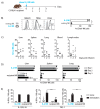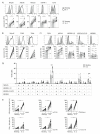Phase I Trial of Prophylactic Donor-Derived IL-2-Activated NK Cell Infusion after Allogeneic Hematopoietic Stem Cell Transplantation from a Matched Sibling Donor
- PMID: 34071607
- PMCID: PMC8198961
- DOI: 10.3390/cancers13112673
Phase I Trial of Prophylactic Donor-Derived IL-2-Activated NK Cell Infusion after Allogeneic Hematopoietic Stem Cell Transplantation from a Matched Sibling Donor
Abstract
Background: NK cell-based immunotherapy to prevent relapse after allogeneic transplantation is an appealing strategy because NK cells can provide strong antitumor effect without inducing graft-versus-host disease (GVHD). Thus, we designed a phase-I clinical trial evaluating the safety of a prophylactic donor-derived ex vivo IL-2 activated NK cell (IL-2 NK) infusion after allo-HSCT for patients with hematologic malignancies. Methods: Donor NK cells were purified and cultured ex vivo with IL-2 before infusion, at three dose levels. To identify the maximum tolerated dose was the main objective. In addition, we performed phenotypical and functional characterization of the NK cell therapy product, and longitudinal immune monitoring of NK cell phenotype in patients. Results: Compared to unstimulated NK cells, IL-2 NK cells expressed higher levels of activating receptors and exhibited increased degranulation and cytokine production in vitro. We treated 16 patients without observing any dose-limiting toxicity. At the last follow up, 11 out of 16 treated patients were alive in complete remission of hematologic malignancies without GVHD features and immunosuppressive treatment. Conclusions: Prophylactic donor-derived IL-2 NK cells after allo-HSCT is safe with low incidence of GVHD. Promising survivals and IL-2 NK cell activated phenotype may support a potential clinical efficacy of this strategy.
Keywords: IL-2-activated NK cells; allogeneic hematopoietic stem cell transplantation; antitumor immunity; cellular immunotherapy.
Conflict of interest statement
E.V. is an employee and shareholder of Innate Pharma. S.U. is shareholder of Innate Pharma. The other authors declare no conflict of interest.
Figures






Similar articles
-
Haploidentical Natural Killer Cells Infused before Allogeneic Stem Cell Transplantation for Myeloid Malignancies: A Phase I Trial.Biol Blood Marrow Transplant. 2016 Jul;22(7):1290-1298. doi: 10.1016/j.bbmt.2016.04.009. Epub 2016 Apr 16. Biol Blood Marrow Transplant. 2016. PMID: 27090958 Free PMC article. Clinical Trial.
-
Expanded donor natural killer cell and IL-2, IL-15 treatment efficacy in allogeneic hematopoietic stem cell transplantation.Eur J Haematol. 2008 Sep;81(3):226-35. doi: 10.1111/j.1600-0609.2008.01108.x. Epub 2008 Jun 28. Eur J Haematol. 2008. PMID: 18573173
-
Alloreactivity as therapeutic principle in the treatment of hematologic malignancies. Studies of clinical and immunologic aspects of allogeneic hematopoietic cell transplantation with nonmyeloablative conditioning.Dan Med Bull. 2007 May;54(2):112-39. Dan Med Bull. 2007. PMID: 17521527 Review.
-
[Experimental study on IL-2- and IL-15 application in allogeneic hematopoietic stem cell transplantation].Zhonghua Xue Ye Xue Za Zhi. 2008 Aug;29(8):526-30. Zhonghua Xue Ye Xue Za Zhi. 2008. PMID: 19112915 Chinese.
-
Natural killer cells in the treatment of high-risk acute leukaemia.Semin Immunol. 2014 Apr;26(2):173-9. doi: 10.1016/j.smim.2014.02.004. Epub 2014 Mar 5. Semin Immunol. 2014. PMID: 24613727 Review.
Cited by
-
Complex interactions of cellular players in chronic Graft-versus-Host Disease.Front Immunol. 2023 Jun 26;14:1199422. doi: 10.3389/fimmu.2023.1199422. eCollection 2023. Front Immunol. 2023. PMID: 37435079 Free PMC article. Review.
-
Genetically modified and unmodified cellular approaches to enhance graft versus leukemia effect, without increasing graft versus host disease: the use of allogeneic cytokine-induced killer cells.Front Immunol. 2024 Oct 24;15:1459175. doi: 10.3389/fimmu.2024.1459175. eCollection 2024. Front Immunol. 2024. PMID: 39512351 Free PMC article. Review.
-
Optimization of Donor Lymphocyte Infusion for AML Relapse After Allo-HCT in the Era of New Drugs and Cell Engineering.Front Oncol. 2022 Jan 27;11:790299. doi: 10.3389/fonc.2021.790299. eCollection 2021. Front Oncol. 2022. PMID: 35155192 Free PMC article. Review.
-
Maintenance therapy for AML after allogeneic HCT.Front Oncol. 2022 Aug 9;12:895771. doi: 10.3389/fonc.2022.895771. eCollection 2022. Front Oncol. 2022. PMID: 36016625 Free PMC article. Review.
-
Cell Therapy as a Way to Increase the Effectiveness of Hematopoietic Stem Cell Transplantation.Cells. 2024 Dec 12;13(24):2056. doi: 10.3390/cells13242056. Cells. 2024. PMID: 39768148 Free PMC article. Review.
References
-
- Lee C.J., Savani B.N., Mohty M., Gorin N.C., Labopin M., Ruggeri A., Schmid C., Baron F., Esteve J., Giebel S., et al. Post-Remission Strategies for the Prevention of Relapse Following Allogeneic Hematopoietic Cell Transplantation for High-Risk Acute Myeloid Leukemia: Expert Review from the Acute Leukemia Working Party of the European Society for Blood and Marrow Transplantation. Bone Marrow Transplant. 2019;54:519–530. doi: 10.1038/s41409-018-0286-2. - DOI - PubMed
-
- Tsirigotis P., Byrne M., Schmid C., Baron F., Ciceri F., Esteve J., Gorin N.C., Giebel S., Mohty M., Savani B.N., et al. Relapse of AML after Hematopoietic Stem Cell Transplantation: Methods of Monitoring and Preventive Strategies. A Review from the ALWP of the EBMT. Bone Marrow Transplant. 2016;51:1431–1438. doi: 10.1038/bmt.2016.167. - DOI - PubMed
-
- Kolb H.J., Schattenberg A., Goldman J.M., Hertenstein B., Jacobsen N., Arcese W., Ljungman P., Ferrant A., Verdonck L., Niederwieser D., et al. Graft-versus-Leukemia Effect of Donor Lymphocyte Transfusions in Marrow Grafted Patients. Blood. 1995;86:2041–2050. doi: 10.1182/blood.V86.5.2041.bloodjournal8652041. - DOI - PubMed
Grants and funding
LinkOut - more resources
Full Text Sources

